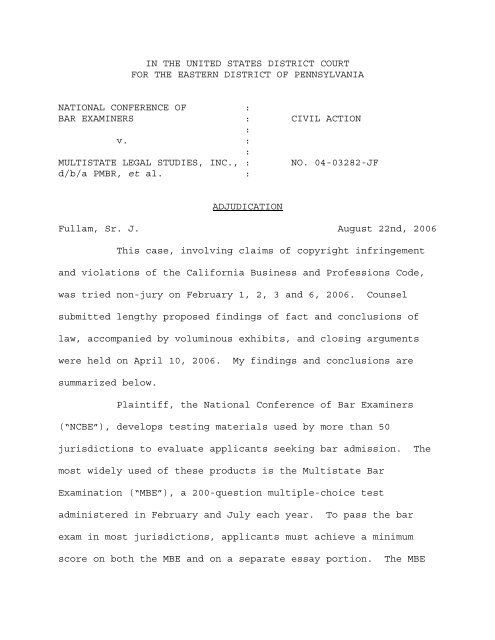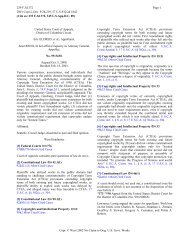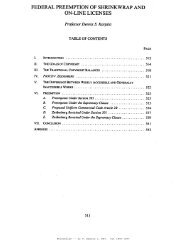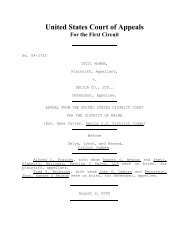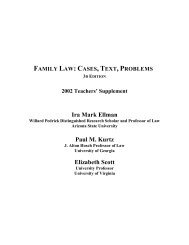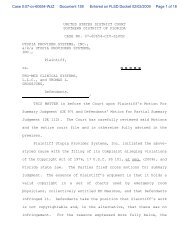National Conference of Bar Examiners v. Multistate Legal Studies, Inc.
National Conference of Bar Examiners v. Multistate Legal Studies, Inc.
National Conference of Bar Examiners v. Multistate Legal Studies, Inc.
- No tags were found...
You also want an ePaper? Increase the reach of your titles
YUMPU automatically turns print PDFs into web optimized ePapers that Google loves.
IN THE UNITED STATES DISTRICT COURTFOR THE EASTERN DISTRICT OF PENNSYLVANIANATIONAL CONFERENCE OF :BAR EXAMINERS : CIVIL ACTION:v. ::MULTISTATE LEGAL STUDIES, INC., : NO. 04-03282-JFd/b/a PMBR, et al. :ADJUDICATIONFullam, Sr. J. August 22nd, 2006This case, involving claims <strong>of</strong> copyright infringementand violations <strong>of</strong> the California Business and Pr<strong>of</strong>essions Code,was tried non-jury on February 1, 2, 3 and 6, 2006. Counselsubmitted lengthy proposed findings <strong>of</strong> fact and conclusions <strong>of</strong>law, accompanied by voluminous exhibits, and closing argumentswere held on April 10, 2006. My findings and conclusions aresummarized below.Plaintiff, the <strong>National</strong> <strong>Conference</strong> <strong>of</strong> <strong>Bar</strong> <strong>Examiners</strong>(“NCBE”), develops testing materials used by more than 50jurisdictions to evaluate applicants seeking bar admission. Themost widely used <strong>of</strong> these products is the <strong>Multistate</strong> <strong>Bar</strong>Examination (“MBE”), a 200-question multiple-choice testadministered in February and July each year. To pass the barexam in most jurisdictions, applicants must achieve a minimumscore on both the MBE and on a separate essay portion. The MBE
covers topics in contracts, criminal law and procedure,constitutional law, real property, evidence, and torts. Eachquestion comprises a brief fact pattern, a lead-in asking thetest-taker about a particular legal issue, and four answerchoices. Drafting these questions is a lengthy process for whichNCBE retains panels <strong>of</strong> pr<strong>of</strong>essors, judges, and practitioners.Each MBE contains approximately 60 questions from earlier teststo provide a basis for comparing the performance <strong>of</strong> applicants onone MBE with that <strong>of</strong> previous groups. Using these data,plaintiff corrects for variations in the degree <strong>of</strong> difficulty <strong>of</strong>the examination when computing individual scores. Questions mayappear on several MBEs before being retired.Because plaintiff reuses many MBE questions, it goes togreat lengths to maintain the secrecy <strong>of</strong> those questions. NCBEsubmits the MBE to the Register <strong>of</strong> Copyrights under regulationsthat exempt secure tests from the deposit requirement. 37 C.F.R.§§ 202.20(b)(4), 202.20(c)(2)(vi); see also <strong>National</strong> <strong>Conference</strong><strong>of</strong> <strong>Bar</strong> <strong>Examiners</strong> v. <strong>Multistate</strong> <strong>Legal</strong> <strong>Studies</strong>, <strong>Inc</strong>., 692 F.2d 478(7th Cir. 1982)(upholding the validity <strong>of</strong> regulations governingregistration <strong>of</strong> secure tests). It also takes steps to enforcethis copyright: prohibiting test-takers from discussing orreproducing MBE questions, and resorting to legal action when barreview courses violate these rules. See, e.g., <strong>National</strong>2
<strong>Conference</strong> <strong>of</strong> <strong>Bar</strong> <strong>Examiners</strong> v. Saccuzzo, No. 03-CV-0737, 2003 WL21467772 (S.D. Cal. Jun. 10, 2003). NCBE does releaseapproximately 1100 retired questions, which can be licenced for afee.Defendants Robert Feinberg and Dona Zimmerman founded<strong>Multistate</strong> <strong>Legal</strong> <strong>Studies</strong>, <strong>Inc</strong>. (known as the “Preliminary<strong>Multistate</strong> <strong>Bar</strong> Review” or “PMBR”) in 1977 to sell MBE testpreparationservices. The company currently <strong>of</strong>fers a variety <strong>of</strong>programs: a 3-day class, a 6-day class, and a one-on-onetutorial. These courses provide oral and written instructionalmaterials addressing the substantive law tested on the MBE, testtakingstrategies, and practice MBE questions. PMBR is bothpopular and lucrative, teaching more than 40,000 students in 2004(nearly 60% <strong>of</strong> those taking the MBE) and bringing in more than$16,000,000 in gross revenues that year. In addition to beingthe sole owners <strong>of</strong> PMBR, Mr. Feinberg and Ms. Zimmerman havedrawn millions <strong>of</strong> dollars in salary from the company.The 3-day course, which is the focus <strong>of</strong> thislitigation, is given in approximately 100 locations before theFebruary administration <strong>of</strong> the MBE and 150 locations before theJuly administration. The average cost to students, as estimatedby defendants’ expert, was $254.39 in 2001, $275.62 in 2002,$277.34 in 2003, and $304.74 in 2004. On the first day <strong>of</strong> the3
course, students take a full 200 question simulated MBE, referredto as the “PMBE.” The remaining two days use the PMBE questionsto instruct students on substantive law and test-takingtechniques. Students also receive written answer keys to thePMBE with detailed explanations and citations to the sourcematerials used to develop the questions. Before the inception <strong>of</strong>this lawsuit, defendants incorporated approximately 50 newquestions into each year’s 200-question PMBE. Other coursematerials were revised less frequently and less extensively. Mr.Feinberg generates almost all <strong>of</strong> the PMBE questions andexplanatory answer keys himself, relying in part on hornbooks,treatises, reporters, and published cases. He also admits thathe uses the notes <strong>of</strong> PMBR employees who have taken the MBE inrecent years. PMBR does not retain these notes or any otherdevelopment materials.Many PMBR advertisements use “testimonials” from formerstudents emphasizing the similarity between PMBR practicequestions and those appearing on the MBE. Specifically toutingthe 3-day course, one student praised the quality <strong>of</strong> PMBR’spractice questions, noting that “dozens <strong>of</strong> nearly identicalquestions appeared on the actual exam.” Ex. P255. Anotherreported that he “breezed through the exam because [he]recognized so many <strong>of</strong> the questions from PMBR.” Ex. P253. A4
third reported that he was “already familiar with many <strong>of</strong> thequestions” before taking the MBE. Ex. P256. A fourth exclaimed(in large boldface type) that “It Was Deja Vu All Over Again. IWas Amazed How Similar The Actual MBE Was To PMBR!” Ex. P252.Mr. Feinberg writes other promotional materialshimself. One PMBR brochure explains that:PMBR questions cover issues which are consistently repeatedon the MBE. (PMBR develops its own questions. Some othercourses overplay the value <strong>of</strong> released questions. Sincereleased questions will never be repeated, you will neversee them on the MBE – so who needs ‘em?).Ex. P298. Mr. Feinberg has told students in his 3-day coursethat they can expect to “recognize many <strong>of</strong> these similar types <strong>of</strong>questions on the actual exam,” Ex. P292, and pointed outparticular PMBE questions that were very similar to recent MBEquestions. Predictably, some <strong>of</strong> those questions are at issue inthis suit, e.g. 1544_RLP from the February 2003 MBE and 1327_TORwhich appeared on four MBEs from 1992 through 2003.PMBR is able to expose students to “the latest, thenewest questions covering the newest distinctions that weretested [on the MBE],” Ex. P287, because the company’s employeessit for nearly every administration <strong>of</strong> the examination. Aftercompleting the MBE, these employees take notes on the topicscovered, and in some instances on the specific facts <strong>of</strong> questionsor their answer choices. Mr. Feinberg has personally taken the5
MBE more than 20 times, and Ms. Zimmerman more than a dozen.Given that these individuals are highly paid to prepare studentsto take (and presumably to pass) the bar exam, their failure rateis strikingly high. Mr. Feinberg, for example, failed fiveconsecutive bar examinations in Alaska before barely passing inFebruary 2004. Once an applicant passes the bar in a givenjurisdiction, he may not take it there again. Perhaps even morestartling, Ms. Zimmerman twice failed the Kentucky <strong>Bar</strong>Examination despite passing the essay portion, because her scoreson the MBE were so low. Her testimony that she failed becausethe MBE “is quite a difficult examination” speaks poorly <strong>of</strong>either her pr<strong>of</strong>essional qualifications or her credibility as awitness.The events leading to this lawsuit began in Anchoragein February 2003. At the time, Alaska was the only jurisdictionthat permitted the use <strong>of</strong> scratch paper during the MBE. Even so,students were strictly prohibited from removing scratch paper orother exam materials from the testing room. At the conclusion <strong>of</strong>the afternoon MBE session, Mr. Feinberg broke this rule. As hewas leaving the room, a proctor noticed that he was carrying asheet <strong>of</strong> scratch paper with notes on it. She stopped him,confiscated the paper, and filed an Irregularity Report withNCBE. While the notes on the paper are brief and somewhat6
cryptic, they clearly relate to topics and answer choices <strong>of</strong>particular MBE questions. Upon receiving the Alaska IrregularityReport in April 2003, NCBE undertook an extensive review <strong>of</strong> thedefendants’ course materials, comparing each PMBE questionpublished from 2001 onward to a database <strong>of</strong> MBE questions. Afterconcluding that more than 100 questions had likely been copied,plaintiffs filed this lawsuit.A plaintiff alleging copyright infringement must proveboth ownership <strong>of</strong> a valid copyright and copying <strong>of</strong> the originalelements <strong>of</strong> the protected work. See Feist Publications, <strong>Inc</strong>. v.Rural Telephone Service Co., <strong>Inc</strong>., 499 U.S. 340, 361 (1991). AsI rejected defendants’ attempts to challenge NCBE’s copyright inorders <strong>of</strong> April 13 and July 21, 2005, all that remains is thequestion <strong>of</strong> copying. I find that plaintiff has proven copyingboth with direct evidence and by demonstrating that there issubstantial similarity between the MBE and PMBE questions.This is the rare case in which there is direct evidencethat defendants copied plaintiff’s work. See Rottlund Co. v.Pinnacle Corp., 452 F.3d 726, 732 (8th Cir. 2006) (“Directevidence <strong>of</strong> copying is rarely available because it includesevidence such as party admissions, witness accounts <strong>of</strong> thephysical act <strong>of</strong> copying, and common errors in the works <strong>of</strong>plaintiffs and the defendants.”). Mr. Feinberg and other PMBR7
employees regularly write down information about the factpatterns, prompts, and answer choices appearing on MBEexaminations that they have taken. Mr. Feinberg admitted that heuses these notes when writing PMBE questions. In order t<strong>of</strong>acilitate this process, PMBR employees sought out the onlyjurisdiction that allowed test-takers to use scratch paper,taking (and in all but one case failing) the Alaska <strong>Bar</strong> Exameight times from 2001 through 2003. In February 2003, Mr.Feinberg was caught leaving the examination room with his scratchpaper. In addition, PMBR advertisements brag about how close itsquestions are to those on the actual MBE, and Mr. Feinberg hasmade similar statements. Finally, many PMBE questions reproduceMBE questions nearly verbatim, and others contain trivialvariations that suggest awareness <strong>of</strong> copying. 1See M. KramerMfg. Co., <strong>Inc</strong>. v. Andrews, 783 F.2d 421, 446 (4th Cir. 1986). Iconclude that defendants willfully copied MBE questions, eitherby setting out to do so, or engaging in behavior that was socertain to lead to copying that intent must be inferred.1To cite just one example, a PMBE question refers to “X-10gidgets,” while the MBE question from which it is copied involves“X10 widgets.” There could be no more trivial variation. Theirrelevant PMBE explanation that a “gidget is a syntheticreplication <strong>of</strong> a widget” confirms awareness <strong>of</strong> copying.8
The substantial similarity between most <strong>of</strong> theallegedly infringing PMBE questions and copyrighted MBE itemsbolsters this conclusion. Because defendants do not dispute thatthey had access to plaintiff’s copyrighted questions, plaintiffwill prevail if there is “sufficient similarity between the worksso as to conclude that the alleged infringer ‘copied’ the work,”and the similarity relates to the protectable aspects <strong>of</strong> theallegedly infringed work. Dam Things from Denmark v. Russ Berrie& Co., 290 F.3d 548, 562 (3d Cir. 2002).After reviewing each pair <strong>of</strong> MBE and allegedlyinfringingPMBE questions, I conclude that nearly all <strong>of</strong> the 113challenged questions are substantially similar to copyrighted MBEquestions. 2 In many instances, evidence <strong>of</strong> copying practicallyleaps from the page. One such egregious example is based on1792_CNL, which appeared on the July 1999 MBE:As Part <strong>of</strong> the Federal Deficit Eradication Act, Congressimposed a special tax on “all interest in excess <strong>of</strong> 5% perannum earned by each state <strong>of</strong> the United States on any <strong>of</strong>its investments.” This tax is probably2Only a handful <strong>of</strong> PMBE questions, such as those allegedlybased on MBE questions 1270_CNL, 1588_EVD, and 1886_EVD, do notnecessarily appear to be copied, either because the MBE questionsinvolve common legal principles presented in a very generalizedway or because the similar aspects relate only to the area <strong>of</strong> lawbeing tested, and not to specific facts or answer choices.9
(A) constitutional, because it does not discriminate amongthe several states – it treats all <strong>of</strong> them in the samemanner.(B)(C)(D)constitutional, because it taxes only a proprietary function <strong>of</strong>the states – it does not tax any <strong>of</strong> their strictly governmentalfunctions.unconstitutional, because it singles out state governments forspecial taxation that is not applicable to any other entities orindividuals.unconstitutional, because it requires a state government itselfto make a tax payment to the United States.Answer key: CQuestion #27 on the 2001 PMBE, repeated as question #142 on theJuly 2004 PMBE, reproduced much <strong>of</strong> this question verbatim:Congress has passed a new federal statute called the FederalDeficit Eradication Act. The law imposed a special tax onall interest in excess <strong>of</strong> 5% per annum earned by each stateon any investments made by the respective state(s)The state <strong>of</strong> Texas has filed an appropriate action infederal district court challenging the constitutionality <strong>of</strong>the federal statute. In all likelihood the court will findthe Federal Deficit Eradication Act to be(A)(B)(C)(D)constitutional, because the law does not discriminateamong the several statesconstitutional, because the incidence <strong>of</strong> the tax is oninterest payments from outside investments and does notapply to government functionsunconstitutional, because it places a discriminatoryburden on state governmentsunconstitutional, because the tax burden applies tostate governmental bodies and not the residents <strong>of</strong> thestate10
Answer key: BThis question tests the same legal concept using the samefictitious statute and four virtually identical answer choices inthe same order. 3 As with a number <strong>of</strong> PMBE questions, the answerkey here is incorrect, further undermining Mr. Feinberg’s claimsthat he derived his questions independently from authoritativelegal sources.While many PMBE questions exhibit this degree <strong>of</strong>similarity, less-than-wholesale reproduction can also provide asufficient basis to conclude that there was copying. SeeEducational Testing Service v. Simon, 95 F. Supp. 2d 1081, 1088(C.D. Cal. 1999)(“[I]mmaterial variations do not alter theconclusion that infringing material is substantially similar tocopyrighted material.”). Question #120 on the 2002/2003 PMBE,repeated as question #174 on the July 2004 PMBE and #20 on the2005 PMBE, involves all <strong>of</strong> the same material facts as MBEquestion 1672_TOR, which appeared in July <strong>of</strong> 2001. The MBEquestion reads in relevant part:Agent arranged a dinner meeting with Customer, a prospectivestockholder. During dinner, Agent made several false andmisleading statements to Customer regarding the financial3Mr. Feinberg testified that he was “very surprised” atthe similarity between these two questions even though herecalled seeing the MBE question when taking the examination andwriting the PMBE question afterwards. Tr. 2/3/06 at 80-81.11
soundness <strong>of</strong> Company. Waiter, who was serving the tablenext to Agent and Customer, overheard the statements. Basedon those statements, Waiter purchased a substantial number<strong>of</strong> shares <strong>of</strong> Company stock. Within weeks after Waiter’spurchase, Company filed for bankruptcy and Waiter lost hisentire investment. In a suit by Waiter against Agent torecover for his loss, will Waiter prevail?(A) Yes, because Waiter reasonably relied on the statementsmade by Agent.(B) Yes, because Agent should have foreseen that Waiterwould hear the false statements.(C) No, because Agent was not attempting to induce Waiterto purchase any Company stock.(D) No, because investing in newly issued stock is toospeculative.Answer key: CThe PMBE question also involves a waiter who overhears fraudulentinsider information not intended for his ears, invests his moneybased on this information, loses it, and sues the one who madethe statements. Two <strong>of</strong> the answer choices are also nearlyidentical:Bilko was an investment swindler who ran a Ponzi scheme.One evening he took a group <strong>of</strong> unwitting investors to dinnerhoping to convince them to invest in a new business venture.At the restaurant Bilko falsely told the gathering that hiscompany’s stock price would appreciate 200% within threemonths. Dupe, a waiter at the restaurant, overheard Bilko’spresentation and decided to invest in the enterprisehimself. Thereafter, Dupe invested $10,000, his entire lifesavings, in Bilko’s business venture. Two months laterBilko’s company became insolvent and filed for bankruptcy.If Dupe sues Bilko for fraud seeking to recover damages forhis investment loss, will he prevail?12
(A) Yes, because Bilko should have been aware that otherpeople may have overheard his false statements.(B)Yes, because Bilko provided false information which wasrelied on by Dupe.(C) No, because Bilko did not intend to induce Dupe to actin reliance and invest in his investment scheme.(D)No, because Bilko did not direct his statements to Dupewho happened to be eavesdropping on the conversation.Answer key: CWhile defendants included some original language and factualembellishments, they clearly copied the question from the oneappearing on the MBE.In all, defendants copied well over 100 PMBE questionsfrom the MBE, in many cases duplicating passages nearly verbatimor reproducing labyrinthine fact patterns turn by turn.Having determined that there was copying, I now turn towhether the copied elements are subject to copyright protection.MBE questions may reflect original expression in their wording,particularized facts, and answer choices. Defendants argue thatthey should be afforded only limited protection because they testestablished legal rules within a relatively narrow set <strong>of</strong> formalconstraints. This is a fundamental misreading <strong>of</strong> EducationalTesting Services v. Katzman, 793 F.2d 533, 542 (3d Cir. 1986),which recognized that there is protectable expression even in amultiple choice question designed to test knowledge <strong>of</strong> basic13
mathematical concepts, such as square roots and fractions. Seealso Ass’n <strong>of</strong> Am. Med. Colls. v. Mikaelian, 471 F. Supp. 144, 150(E.D. Pa. 1983). Teaching the legal principles tested on the MBEis permissible. Doing so using the same fact patterns, prompts,and answer-choice combinations found in MBE questions is not.MBE questions based on published cases or newspaperarticles are protectable to the extent that they include materialalterations in the facts, new legal issues, or original answerchoices. For example, question 1033_CRM, which appeared on theFebruary 2001 MBE, drew on a 1993 New York Times articlereporting that a court clerk had been charged with murder aftersmuggling a firearm into the courthouse for her boyfriend, whoused it to kill a police <strong>of</strong>ficer. See Joseph F. Sullivan, ClerkAccused <strong>of</strong> Smuggling Gun in Courthouse Killing, N.Y. Times, June5, 1993, at A11. Inspired by this article, the MBE draftersdeveloped a question designed to test the defenses <strong>of</strong> duress,necessity, and insufficient mens rea. In so doing, they addedtwo key facts not appearing in the article: that the gunman toldthe clerk that he wanted her to smuggle the gun so that hisprobation <strong>of</strong>ficer would not discover it, and that he threatenedto kidnap her children if she refused to cooperate. Thequestion’s focus on the clerk’s best defense and the fourspecific answer choices also reflect creative expression. A PMBE14
question from 2003/2004 copied the additional facts, prompt, andthree <strong>of</strong> the same answer choices, all <strong>of</strong> which are protected byplaintiff’s copyright.In other instances, the creative expression is embodiedin the answer choices, rather than in the fact patterns alone.The fact pattern in question 1999A_EVD, for example, is sogeneral that it would not, on its own, qualify for copyrightprotection:In a prosecution for murder, the judge has discretion toDENY which <strong>of</strong> the following requests made by theprosecution?The extremely open ended nature <strong>of</strong> the question, however,increases the degree <strong>of</strong> creativity involved in drafting the onecorrect and three incorrect answer choices. Question #19 fromthe 2003/2004 PMBE would not violate plaintiff’s copyright simplybecause the fact pattern is materially similar, however it alsouses four substantively identical answer choices, and thiswholesale reproduction <strong>of</strong> a copyrighted question is notpermitted.I find defendants’ claims <strong>of</strong> independent creation to bewholly incredible. The “source binders” submitted are simplypost hoc efforts to identify sources that could, theoretically,have been used. Even so, many <strong>of</strong> the “sources” simply providesupport for the legal principle being tested, lacking anything15
elated to the creative choices made by plaintiff in drafting MBEquestions. Notably, even when plaintiff was inspired by a caseor newspaper article, defendants’ “source binders” <strong>of</strong>ten omitthese clearly related materials. In addition, defendants did notdraft any new PMBE questions for 18 months after agreeing not totake the MBE while this suit was pending. Defendants also failedto provide a credible legitimate explanation for the strikingsimilarity in the wording <strong>of</strong> many PMBE and MBE questions.I also reject defendants’ attempt to invoke laches andestoppel. Their contention that plaintiff’s failure to object toearlier PMBE questions that may have violated NCBE copyrightsholds no merit. The issue in this case is whether 113 specificquestions are infringing, and defendants could not reasonablyhave taken plaintiff’s silence after publication <strong>of</strong> otherquestions as general permission to engage in copyrightinfringement. All but thirteen <strong>of</strong> the infringing questions werefirst published by PMBR within the statutory limitations period,creating a strong inference that plaintiff timely asserted itsclaim. 4 Seven <strong>of</strong> these thirteen were first published in 2001,4While defendant’s proposed findings <strong>of</strong> fact suggests thatthere are 26 such questions, it identifies only 21. Six <strong>of</strong> thosequestions are not currently being challenged by plaintiff, and Iconclude that two others, 1588_EVD and 1886_EVD, are not similarenough to suggest copying.16
and thus may also have been challenged within the limitationsperiod. To the extent that challenged questions first appearedprior to the limitations period, I find that plaintiffs did nothave actual knowledge <strong>of</strong> the infringement until October <strong>of</strong> 2003and that they were not on constructive notice before that date.Plaintiff’s earlier copyright infringement suits againstdefendants 5 did not give rise to a general duty to police allPMBR materials. Cf. Kepner-Tregoe, <strong>Inc</strong>. v. ExecutiveDevelopment, <strong>Inc</strong>., 79 F. Supp. 2d 474, 487-89 (D.N.J. 1999)(imposing a duty to police when plaintiff had previously sueddefendant over the same copyright and had reason to believe thatthe infringement had been continuous since that time).Defendants also argue constructive notice based on reviews <strong>of</strong>PMBR materials by an external consulting firm in 1996, 1998, and2001. Only the 2001 review might potentially have discovered any<strong>of</strong> the questions in-suit, and it did not reveal suspect5In 1978, NCBE sued PMBR for copyright infringement, andunfair competition and deceptive trade practices. Plaintiffdropped its copyright claim after concluding that the allegedinfringement had ceased, and lost on its other claim. <strong>National</strong><strong>Conference</strong> <strong>of</strong> <strong>Bar</strong> <strong>Examiners</strong> v. <strong>Multistate</strong> <strong>Legal</strong> <strong>Studies</strong>, <strong>Inc</strong>.,692 F.2d 478 (7th Cir. 1982). In 1990, NCBE sued PMBR in thisDistrict, alleging copyright infringement. The parties enteredinto a court-approved settlement later that year, and spent thenext five years squabbling over issues relating to thatagreement. See <strong>National</strong> <strong>Conference</strong> <strong>of</strong> <strong>Bar</strong> <strong>Examiners</strong> v.<strong>Multistate</strong> <strong>Legal</strong> <strong>Studies</strong>, <strong>Inc</strong>., Civil Action No. 90-1471 (E.D.Pa.)(Weiner, J.).17
questions. Plaintiff hired a well-respected consulting firm todo these reviews and reasonably relied on the results. Iconclude that these reviews in fact demonstrate a good-faitheffort on the part <strong>of</strong> plaintiffs to detect infringement.Plaintiffs waited less than one year between discovering theinfringement and filing suit, well within permissible bounds.Defendants infringed plaintiff’s copyright, and damagesmust now be determined. NCBE has elected to pursue actualdamages plus PMBR’s pr<strong>of</strong>its, rather than statutory damages,pursuant to 17 U.S.C. § 504(a). I find that the evidencesupports awarding both actual damages and apportionment <strong>of</strong> PMBR’srevenues.Actual damages may include both the direct expensesresulting from the copyright infringement and the loss in thefair market value <strong>of</strong> the copyright. I conclude that the July2005 MBE had to be reprinted at a cost <strong>of</strong> $59,000 becausedefendants’ copyright infringement had compromised the initialversion. There was no evidence <strong>of</strong> other expenses or <strong>of</strong> any lossin the market for plaintiff’s copyrighted materials. I alsodecline plaintiff’s invitation to award lost licensing fees,which are appropriate when copyright infringement substitutes foror interferes with a hypothetical contract between the parties.See, e.g., Davis v. The Gap, <strong>Inc</strong>., 246 F.3d 152, 166-67 (2d Cir.18
2001). Here, I find that there could not have been such acontract: there is no fair market value for the infringedquestions, because to release current MBE questions is toundermine the validity <strong>of</strong> the entire examination; there is alsono evidence to suggest that defendants would have licensedreleased questions, because such questions do not provide thecrucial information defendants sought – previews <strong>of</strong> upcomingtests. Since plaintiff lost no hypothetical royalties, I cannotaward actual damages in compensation. I can and will, however,factor the uniquely proprietary nature <strong>of</strong> the infringed questionsinto apportionment <strong>of</strong> defendants’ pr<strong>of</strong>its.In order to recover lost pr<strong>of</strong>its, the owner <strong>of</strong> aninfringed copyright “is required to present pro<strong>of</strong> only <strong>of</strong> theinfringer's gross revenue.” 17 U.S.C. § 504(b). It is theinfringer’s burden “to prove his or her deductible expenses andthe elements <strong>of</strong> pr<strong>of</strong>it attributable to factors other than thecopyrighted work.” Id. NCBE met its burden by proving the grossrevenues generated by PMBR’s 3-day course. Because defendantsdid not introduce any evidence <strong>of</strong> expenses or other factors towhich pr<strong>of</strong>it should be attributed, I use gross revenues as themeasure <strong>of</strong> defendants’ pr<strong>of</strong>it. Relying on the average cost perstudent, supplied by defendants’ expert, and the number <strong>of</strong>students who took the course, I conclude that defendants’19
evenues from the 3-day course from July 2001 through 2005 were$35,708,361. 6 These revenues will be apportioned, and damagesawarded only to the extent that they are attributable to theinfringement. Doing so does not involve a mathematical formula,but rather an assessment <strong>of</strong> the relative importance <strong>of</strong> theinfringing questions. See, e.g., Bruce v. Weekly World News,<strong>Inc</strong>., 310 F.3d 25, 31-32 (1st Cir. 2002); Blackman v. HustlerMagazine, <strong>Inc</strong>., 800 F.2d 1160, 1164-65 (D.C. Cir. 1986).In determining how much <strong>of</strong> defendants’ revenues toaward, I take into account PMBR’s advertisements and excerptsfrom Mr. Feinberg’s lectures. The heavy emphasis on similaritybetween PMBE questions and MBE questions suggests that this is amajor selling-point for the company. It is not difficult tounderstand why this might be the case, as PMBR’s potentialcustomers are almost all already enrolled in a general bar-reviewcourse that includes MBE preparation. Some students may enroll6While the average cost per student undoubtedly rose againin 2005, it was plaintiff’s burden to introduce such evidence, soI have not accounted for any increase in calculating 2005revenues.2001: 19,503 students x $254.39 = $ 4,961,3682002: 24,853 students x $275.62 = $ 6,849,9842003: 25,150 students x $277.34 = $ 6,975,1012004: 26,497 students x $304.74 = $ 8,074,9692005: 29,032 students x $304.74 = $ 8,847,212Total $35,708,36120
in PMBR simply to get extra practice or to access the particularexpertise <strong>of</strong> its instructors, but there can be no question thatthe high quality <strong>of</strong> PMBR questions is a major attraction. Whilethis quality may be due in part to the ability <strong>of</strong> defendants togenerate realistic practice questions, the evidence in this casereveals that it is largely a result <strong>of</strong> blatant copyrightinfringement. On the other hand, students taking the 3-daycourse also receive workbooks containing 2000 other practicequestions, substantive law outlines, and study aids. Still, thePMBE is clearly the heart <strong>of</strong> the course. Because questionsimilarity is a major draw, and because infringing questions madeup close to 40% <strong>of</strong> the PMBE from 2003 through 2005 (though asubstantially lower percentage in 2001 and 2002), I conclude thatattributing one-third <strong>of</strong> defendants’ revenues to the infringingquestions is justified. Plaintiffs will be awarded $11,902,787.I find that injunctive relief is also warranted, ascopyright liability has been established, and there is a realthreat <strong>of</strong> future infringement. 17 U.S.C. § 502. Defendants willbe enjoined from copying, duplicating, distributing, selling,publishing, reproducing, renting, leasing, <strong>of</strong>fering or otherwisetransferring or communicating in any manner, orally or inwritten, printed, photographic or other form, including anycommunication in any class or other presentation, any questions21
obtained directly from any <strong>of</strong> NCBE’s copyrighted secure tests.See Katzman, 793 F.2d at 544-545.I also find that defendants violated the CaliforniaBusiness and Pr<strong>of</strong>essions Code by intentionally reproducing MBEquestions, thereby subverting a licensing examination taken bythousands <strong>of</strong> applicants seeking admission to the California <strong>Bar</strong>each year. See Cal. Bus. & Pr<strong>of</strong>. Code §§ 17200-209; 123-123.5.This statute entitles plaintiff to restitution and injunctiverelief. I conclude that the damages already awarded provide fullrestitution. Because <strong>of</strong> the likelihood <strong>of</strong> future violations,defendants, their employees, and agents will be enjoined fromtaking any <strong>Multistate</strong> <strong>Bar</strong> Examination for any purpose other thanto obtain bar admission in the jurisdiction in which theexamination is being given.Guided by the factors articulated by our Court <strong>of</strong>Appeals, I conclude that an award <strong>of</strong> reasonable attorney’s feesand costs is justified. See Lowe v. Loud Records, 126 Fed. Appx.545, 547 (3d Cir. 2005). Defendants’ willful and egregiouscopyright infringement harmed the public as well as plaintiffs.States have a compelling interest in regulating admission to thebar both to maintain the integrity <strong>of</strong> the legal system and toprotect the safety <strong>of</strong> their citizens. By exposing its studentsto questions likely to appear on the MBE, PMBR undermined the22
integrity <strong>of</strong> the bar examination, possibly causing the admission<strong>of</strong> unqualified applicants. That the victims <strong>of</strong> this harm areimpossible to identify and the injury impossible to quantifyunderscores the need to deter would-be copyright infringers.An Order follows.23
IN THE UNITED STATES DISTRICT COURTFOR THE EASTERN DISTRICT OF PENNSYLVANIANATIONAL CONFERENCE OF :BAR EXAMINERS : CIVIL ACTION:v. ::MULTISTATE LEGAL STUDIES, INC., : NO. 04-03282-JFd/b/a PMBR, et al. :ORDERAND NOW, this 22nd day <strong>of</strong> August 2006, IT IS ORDEREDthat:1. JUDGMENT is ENTERED in favor <strong>of</strong> the plaintiff,<strong>National</strong> <strong>Conference</strong> <strong>of</strong> <strong>Bar</strong> <strong>Examiners</strong>, and against the defendants,<strong>Multistate</strong> <strong>Legal</strong> <strong>Studies</strong>, <strong>Inc</strong>., Robert Feinberg, and DonaZimmerman jointly and severally, in the sum <strong>of</strong> $11,961,787.2. Defendants are enjoined from copying, duplicating,distributing, selling, publishing, reproducing, renting, leasing,<strong>of</strong>fering or otherwise transferring or communicating in anymanner, orally or in written, printed, photographic or otherform, including any communication in any class or otherpresentation, any questions obtained directly from any <strong>of</strong> NCBE’scopyrighted secure tests.3. Defendants, their employees, and agents areenjoined from taking any <strong>Multistate</strong> <strong>Bar</strong> Examination for any
purpose other than to obtain bar admission in the jurisdiction inwhich the examination is being given.4. Plaintiff may submit an application for attorney’sfees, costs, and prejudgment interest within 20 days, anddefendants may respond within 10 days thereafter.BY THE COURT:/s/ John P. FullamJohn P. Fullam, Sr. J.2


